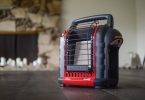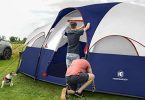We may receive commissions when you buy through the links on our site. Full Disclaimer.
Ever woken up to what feels like an indoor rain shower in your tent? You’re not alone! Tent condensation is every camper’s nemesis, but I’ve got good news – with the right know-how, you can keep those pesky water droplets at bay. After years of testing different methods and helping fellow outdoor enthusiasts, I’m excited to share these game-changing strategies that’ll keep your tent dry and cozy.
Whether you’re dealing with a tent that stands up to high winds or one that needs some extra protection, these tips will make a world of difference. Let’s dive in and make damp tent mornings a thing of the past!

Understanding Why Your Tent Gets Wet Inside
Before we tackle solutions, let’s get to know our enemy. Condensation forms when warm air meets cold surfaces – it’s as simple as that! Each person in your tent releases about a liter of moisture just by breathing overnight. Add in wet gear and damp ground, and you’ve got yourself a mini rain cloud inside your shelter.
Smart Campsite Selection: Your First Line of Defense
Where you pitch your tent makes a huge difference! Here are my tried-and-true spot-picking tips:
- Choose higher ground – at least 50 feet above water sources
- Look for natural wind protection without blocking all airflow
- Pick spots with granitic or sandy soil (they release less moisture)
- Avoid low-lying areas where cold, damp air settles
Ventilation: The Key to Moisture Control
Proper airflow is crucial for keeping things dry. If you’re using a tent with an AC port, you’re already ahead of the game in terms of ventilation options. For everyone else, try these techniques:
- Keep a 4-6 inch gap between your rainfly and tent body
- Position your tent at a 45° angle to prevailing winds
- Open opposing vents for cross-ventilation
- Use a small battery-powered fan for extra air movement
Gear and Material Solutions
Sometimes your tent might need an extra layer of protection. Consider using a quality tent waterproofing spray on the outside, but don’t forget these moisture-fighting tools:
- Microfiber towels to wipe down walls in the morning
- Silica gel packets strategically placed in corners
- Moisture-absorbing products like DampRid
- Anti-condensation mats for under your sleeping pad
Smart Camping Habits That Make a Difference
Some of the most effective solutions don’t cost a dime – they just require a change in habits:
- Cook outside your tent to reduce steam
- Store wet gear in the vestibule, not inside
- Shake out sleeping bags each morning
- Leave tent doors slightly open when weather permits
Special Considerations for Different Seasons
Your condensation strategy should change with the seasons:
Winter Camping
- Use a double-wall tent designed for cold weather
- Consider a small tent-safe heater
- Ventilate more, not less (counterintuitive but crucial!)
Summer Camping
- Maximize airflow during humid nights
- Use minimal rain fly coverage when possible
- Set up in breezy areas
Advanced Moisture Management Technology
For those willing to invest in extra comfort, these high-tech solutions can make a big difference:
- Portable dehumidifiers (battery-powered options available)
- Temperature-regulating tent materials
- Smart venting systems
When to Accept Some Condensation
Sometimes, a little moisture is unavoidable. Focus on managing what you can control, and don’t let perfect be the enemy of good. Even a 60-80% reduction in condensation will make your camping experience much more enjoyable!
Wrap-Up: Your Action Plan for a Drier Tent
Remember, fighting condensation is about combining multiple strategies – there’s no single silver bullet. Start with proper site selection, add smart ventilation, use appropriate gear, and adjust your camping habits. With these techniques in your outdoor toolkit, you’re well on your way to more comfortable camping adventures!
Ready to put these tips to the test? Your next camping trip is going to be a whole lot drier.
Happy camping!




